How Many Cryptocurrencies Are There in 2025?
The crypto markets are on a literal roll, and thanks to the tumultuous start of 2025, new cryptos are starting to pour into the markets. Ever since the US president-elect launched his own meme coin together with the First Lady, experts and market specialists rushed to analyze future crypto predictions.
But that’s a separate topic. We’re here to review the different cryptocurrencies in 2025 and the latest statistics on the number of cryptocurrencies circulating in the market. So, if you’ve ever wondered how many cryptocurrencies are on the market, you’ve come to the right place.
Table of contents
How Many Cryptocurrencies Are There in Total?
At the time of writing (February 2025) there are more than 10,833 different cryptocurrencies listed on CoinMarketCap and 17,078 on CoinGecko. But this number will change as time goes on.
Why? Well, as we know by now, cryptocurrency projects come and go, and so do their coins. If a project goes bankrupt or better solutions become available, some coins might become obsolete. However, the top 10 biggest cryptocurrencies remain the same, with minor fluctuations. Of course, Bitcoin remains the all-time number 1.

That being said, the main reason why there’s such a difference in the number of listed cryptos on CMC and CoinGecko is that there are active and inactive cryptocurrencies.
- An active cryptocurrency is traded on cryptocurrency exchanges, has ongoing development, and maintains an active community or team with sufficient liquidity, regular transactions, and network activity.
- An inactive cryptocurrency is no longer actively traded, has few development updates, and lacks community engagement.
Why Are There So Many Cryptos?
The sole purpose of virtually all cryptocurrencies is to offer an alternative way of owning and managing funds in comparison to traditional finance. Now, when we analyze this concept more closely, many factors have led to the result we have today – the total market cap of all cryptocurrencies is $1.32 trillion.
One of the biggest factors allowing cryptocurrencies to flourish is that most cryptocurrencies, like Bitcoin and Ethereum, are built on open-source code. This allows developers to copy, modify, and build their own technologies.
This led to a completely democratized and open space for everyone to not only participate in the governance of cryptocurrency projects but also in their creation. The low entry barrier feature, offered by platforms like Ethereum (ERC-20), Binance Smart Chain (BEP-20), and Solana, allows users to create new tokens without extensive technical knowledge.
Additionally, with so many cryptos and new projects, there’s also a huge variety of specialized use cases, further attracting wider audiences’ attention. There are many different categories, but the most popular ones include:
- Payments: Bitcoin (BTC), Litecoin (LTC).
- Smart contracts: Ethereum (ETH), Solana (SOL).
- Privacy: Monero (XMR), Zcash (ZEC).
- Stablecoins: Tether (USDT), USD Coin (USDC).
- Decentralized Finance (DeFi): Uniswap (UNI), Aave (AAVE).
- Gaming & NFTs: Axie Infinity (AXS), Flow (FLOW).
Regulative uncertainty, even with increased government attention, is also a driving factor. While the lack of regulations and compliance policies has led to fraudulent projects, the underlying potential of cryptocurrencies and blockchain technology is immense.
The Main Cryptocurrency Types
Cryptocurrencies can be categorized based on their function, technology, and purpose. Below are the primary types:
- Payment cryptocurrencies: Bitcoin (BTC), Litecoin (LTC), Bitcoin Cash (BCH), Dash (DASH).
- Smart contract platforms: Ethereum (ETH), Solana (SOL), Cardano (ADA), Avalanche (AVAX).
- Stablecoins: Tether (USDT), USD Coin (USDC), DAI, Binance USD (BUSD).
- Privacy coins: Monero (XMR), Zcash (ZEC), Dash (optional privacy mode).
- DeFi tokens (decentralized finance): Uniswap (UNI), Aave (AAVE), MakerDAO (MKR), Compound (COMP).
- Governance tokens: Maker (MKR), Curve DAO (CRV), Uniswap (UNI).
- Utility tokens: Chainlink (LINK), Basic Attention Token (BAT), Filecoin (FIL).
- NFT-based and metaverse tokens: Decentraland (MANA), Axie Infinity (AXS), The Sandbox (SAND).
- Meme coins: Dogecoin (DOGE), Shiba Inu (SHIB), Pepe (PEPE).
What’s the Process of Creating New Cryptocurrencies?
Despite meme coins being an immensely growing industry, making it look like virtually anyone can easily create and launch their own cryptocurrency, the process isn’t that simple. There are very specific steps that should be taken to make sure new digital currencies are launched successfully and remain active. In this section, we’ll provide a brief overview of how that process looks to help you see the bigger picture.
Step 1. Define the Purpose and Use Case
The first step is the most important one and it involves laying out the foundation of a new coin. This means deciding on the purpose of the new crypto coin, the blockchain on which it will be built, and the reason why this crypto will be launched in the first place.
For better or worse, the cryptocurrency industry is severely saturated, so if it’s not a meme coin, the new crypto project will have to stand on a solid background. That’s why it’s crucial to go over the tokenomics, define the total supply (fixed or inflationary), and set the distribution model.
Step 2. Choose a Blockchain or Create a New One
Depending on the available technical resources, you could build your new coin on an existing blockchain or create a new blockchain, especially given the open-source nature of most blockchains.
- Using an existing blockchain: You can consider looking into platforms like Ethereum (ERC-20), Binance Smart Chain (BEP-20), or Solana (SPL). This will make the process much easier and faster, albeit leaving you dependent on a parent blockchain’s rules.
- Creating a new blockchain: This will certainly require custom development using frameworks like Bitcoin Core (C++), Ethereum (Solidity), or Cosmos SDK (Go). Moreover, this will give you full control over your technical needs, but at the same time, may prove to be much more expensive and time-consuming than using an existing blockchain.
Step 3. Develop the Smart Contracts and Code
This is a technical step on which the success of any crypto coin depends. Not to expand on it too much, but this involves using Ethereum or similar networks, to write smart contracts to define the token’s functions (minting, burning, transfers, staking).
The most popular tools for this are Solidity (Ethereum), Rust (Solana), and Move (Aptos). But that’s just the how. The development stage heavily depends on ongoing maintenance and rigorous testing before launching on the mainnet, security audits, and wallet performance testing.
Step 4. List on Exchanges and Provide Liquidity
Once the new crypto is live, it’s crucial to go through the proper processes to have it listed on reputable cryptocurrency exchanges like Paybis, Kraken, Binance, or Coinbase. This is an important step because it will provide liquidity pools for decentralized trading.
Additionally, it’s important to note that before applying for listing, new cryptocurrency projects should also review any necessary compliance and regulation requirements like SEC securities classification.
Step 5. Marketing, Community Building, and Compliance
Finally, the last step is the one that will ensure the longevity of a new cryptocurrency. Covering the technical aspects like publishing a website, detailed whitepaper, and roadmap is one thing, but community engagement is essential.
Sure, marketing and brand hype will bring attention, but honest, constant, and informative communication is what will attract crypto enthusiasts.
What Determines a Coin’s Eligibility for CMC Placing?
There may be thousands of cryptos on CoinMarketCap (CMC), but this major listing platform doesn’t list every cryptocurrency. If you’re interested in how cryptos are listed, or you’re exploring the idea of creating and listing your own cryptocurrency, you should be aware of these several factors for judging a new coin’s eligibility. A new coin project must:
- Represent a legitimate cryptocurrency that should be decentralized and cryptographically secured on a blockchain or distributed ledger technology (DLT).
- Have a functional website and block explorer to provide detailed information like the overall purpose, tokenomics, and roadmap, and help track transactions, wallet addresses, and token supply.
- Be actively traded on a public crypto exchange platform that’s recognized and listed on CoinMarketCap.
- Actively communicate with the CMC team to verify information and provide necessary documentation when and if requested.
These criteria are not exhaustive, and CMC applies an extensive vetting process before listing new coins. For a complete and up-to-date list of eligibility standards, refer to the official CoinMarketCap listing guidelines.
These points are by no means exclusive. When listing coins, CMC goes through an extensive list of standards. In addition to the total amount of cryptocurrencies, you should also be aware of the value they represent. There are trillions of coins on the market, and their price is constantly fluctuating.
The Market Cap represents a coin’s total value. To derive this number, one must multiply all the coins in circulation by their respective value in USD.
How to Track Cryptocurrencies
Whether you’re looking to simply keep tabs on existing cryptos or have more in-depth knowledge of the latest advancements and changes in metrics, market data, upcoming projects, and blockchain trends, the best places to start are listed below.
Cryptocurrency Listing Platforms
Online services that track and display information about different cryptos, including their prices, market capitalization, trading volume, and exchange availability. Investors and crypto enthusiasts use crypto listing platforms to monitor trends, discover new tokens, and review historical data. Examples:
- CoinMarketCap.
- CoinGecko.
- CryptoSlate.
ICO, IDO, and IEO Calendars
These calendars help track upcoming, ongoing, and completed token sales like Initial Coin Offerings (ICOs), Initial DEX Offerings (IDOs), and Initial Exchange Offerings (IEOs) and provide key details like project descriptions, fundraising goals, tokenomics, and launch dates. Examples:
- ICO Drops.
- Polkastarter & DAO Maker.
- Binance Launchpad & Coinbase Launch.
Blockchain Explorers
Blockchain Explorers are online tools traders use to view and track blockchain transactions in real time. You can find detailed insights into blocks, addresses, transaction histories, and network statistics to essentially verify transactions, monitor network activity, and analyze blockchain data. Example:
- Etherscan.
- BscScan.
- Solscan.
Token Screening & Alert Tools
These tools help investors and traders analyze cryptocurrency tokens specifically for legitimacy, performance, and risk factors with features like contract audits, price alerts, rug pull detection, and on-chain activity monitoring. Examples:
- DEXTools.
- TokenSniffer.
- CryptoPanic.
Summing Up
The crypto space is booming, and from what we can see now, new crypto projects will only increase over time. It will certainly be interesting to witness how the situation will change once regulations like MiCA (Markets in Crypto Assets Regulation) kick in, or how the market dynamics will change after the hype of the US presidential meme coins dies down. Keep an eye out for more market overview pieces in the Paybis blog!
FAQ
Which cryptocurrency will explode in 2025?
Truthfully, the current situation in the crypto landscape shows an incredibly favorable atmosphere for cryptocurrencies, especially with the launch of Trump Coin and Melania Coin. However, despite the positive influence, many crypto traders are divided on the topic.
This example shows just how easily the crypto markets can be influenced, which is why we can’t say for certain which crypto will be the most valuable cryptocurrency in 2025. The best advice we can provide is to keep up to date with the latest crypto news and lean on historical data rather than hype.
Why are meme coins growing so much?
Meme coins are experiencing particularly favorable conditions in the cryptocurrency market due to celebrity-backing, branding, community hype, and witty marketing. The fact that the requirements for creating and launching meme coins are relatively easy also plays a role.
Another major factor that fuels people’s interest in meme coins is the opportunity to capitalize on meme coins’ speculative nature, which can be profitable for some. However, meme coins are extremely volatile and should be approached with caution.
How much cryptocurrency is in circulation?
This is a difficult question to answer simply because there are too many cryptos. We can only estimate the rough amount. Just adding the total circulating supply of the top 5 biggest cryptos, Bitcoin, Ethereum, Tether, XRP, and Solana, results in around 200 billion cryptos circulating in the crypto market in early February 2025, as recorded by CoinMarketCap.
Disclaimer: Don’t invest unless you’re prepared to lose all the money you invest. This is a high‑risk investment and you should not expect to be protected if something goes wrong. Take 2 mins to learn more at: https://go.payb.is/FCA-Info


